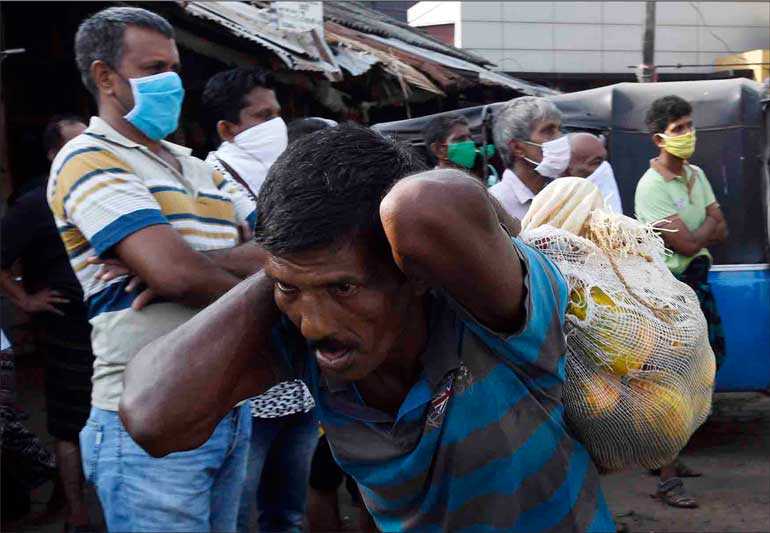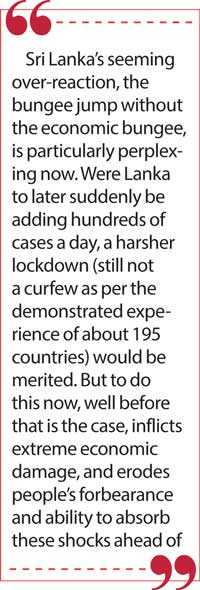Thursday Nov 06, 2025
Thursday Nov 06, 2025
Friday, 3 April 2020 00:00 - - {{hitsCtrl.values.hits}}

I’ve been consulting for leaders around the world for just under 30 years, and for 10 rewarding yet challenging years in Sri Lanka from 1993 to 2003, and intermittently since then.
The current “hysteria industry” which has had us in Lanka panic-stricken into a virtually unique (among 195 countries), multi-week, 24-hours-a-day curfew in key economic epicentres is without parallel from what I know of Sri Lanka’s recent history. This indeed was clearly affirmed as such in the President’s own statement (18 March) 48 hours roughly before the unexpected, never-justified, island-wide curfew, that is increasingly crippling the economy, while having no demonstrable objective impact on the trajectory of COVID-19 here.
This is not an argument for laissez-faire. Border controls, targeted lockdowns, social distancing, testing, contact tracing, hygiene and phased measures as exemplified by the most successful regional and global responders is precisely what the statement suggested, and aspects of which, we have done very well.
An unusual choice
The President rightly stated, that in 30 years of war, never was a complete lockdown of the country and economy needed or exercised. And in my time here, dealing with trauma relief sessions for KLM and Ceylinco right after the Central Bank bombing, being here days after the Galadari bombing, serving clients in the midst of the gas shortage (due to another terrorist incident), the airport attack and much more…life went on, and I marvelled at Sri Lanka’s heroism and resilience.
So, what has spooked us to this extent now? Life is a risky business, and we have to manage risks. At the time of the shutdown, “forecasters” decided we should take our lead from Italy’s situation at the time things went completely out of control there and were running amok.
No argument was ever made why the experience of Vietnam, or Cambodia, or Singapore, or Hong Kong, or Taiwan, where economic activity while necessarily pulled back was still very much underway, and where the outbreaks have been relatively modest and/or fairly effectively contained since action was taken, should not instead be our benchmark?
Balancing risks
I say, ‘life is a risky business’. I am not making light of the pandemic. But by a simple comparison, in 2017 Sri Lanka had 186,101 cases of dengue! We had 440 deaths. We have three deaths at present from COVID-19, all elderly, one patient with a kidney transplant, one with a prior heart attack, the most recent 72 years old with a history of diabetes, high blood pressure and kidney failure… and genuinely sad as that is, this cannot be what kindles what must by now, by sheer mathematics, be at least a $4.5 billion+ impact to an $80 billion per annum economy. And given our debt load here, this is not something to shrug off.
As noted, we have 143 cases of COVID-19 as of 31 March vs 186,101 dengue cases in that 2017 season. Okay, that’s Sri Lanka, what about the rest of the world?
The 2017-18 flu/influenza season was one of the most virulent globally; 45 million (not a typo) were  infected worldwide. US States declared states of emergency, hospitals were over-run, tents were set up as makeshift medical treatment centres, and in the US alone, 61,000 people died. I am not daft enough to want to predict what the COVID numbers will be, but surely we need to allow there to be “milestones” and “gates” that are evidence based, rather than acting reflexively on “models” that have yet no firm underwriting in evidence. Imagine if there had been “hour by hour” breaking news on that influenza/flu season then, or dengue here!
infected worldwide. US States declared states of emergency, hospitals were over-run, tents were set up as makeshift medical treatment centres, and in the US alone, 61,000 people died. I am not daft enough to want to predict what the COVID numbers will be, but surely we need to allow there to be “milestones” and “gates” that are evidence based, rather than acting reflexively on “models” that have yet no firm underwriting in evidence. Imagine if there had been “hour by hour” breaking news on that influenza/flu season then, or dengue here!
As I write, researchers are seeking data on representative sampling of populations, to see which models are actually applicable. This may either confirm that indeed, we must go to severe lockdown, or instead that the infection and fatality rate are actually much closer to severe influenza, or as the recent Oxford study states and is testing, that as up to half of those infected (based on testing done in Iceland and the Italian town of Vo) are asymptomatic, the much touted “herd immunity” may already have been built for many and millions may have had the infection and like Senator Rand Paul and Prince Charles either had no symptoms or extremely mild symptoms, and shrugged it off.
Surely, surely, we need more of this data before the “possibility” of a geometrically multiplying contagion is taken as our non-negotiable fall-back perspective versus the “definite reality” of economies, industrial sectors, emerging markets, businesses and lives, children’s educations and futures, in the literal billions being potentially rent asunder and perhaps irreparably damaged.
Protecting the future
Sri Lanka’s seeming over-reaction, the bungee jump without the economic bungee, is particularly perplexing now. Were Lanka to later suddenly be adding hundreds of cases a day, a harsher lockdown (still not a curfew as per the demonstrated experience of about 195 countries) would be merited. But to do this now, well before that is the case, inflicts extreme economic damage, and erodes people’s forbearance and ability to absorb these shocks ahead of a time when we might actually need them to – unlike now!
Life is “risky business.” We know at a construction site, there will be a certain number of deaths. We allow farmers to work barefoot in the midst of pesticides, leading to illness and death. There are tens of thousands of driving fatalities each year, as there are from crossing the street (more than by any single terrorist incident in recent memory). There are a certain number of flying fatalities, multiple deaths from boating and swimming, many more from skiing, climbing peaks, pilgrimages even. While there are safety measures and best practice mitigation is in evidence in all these instances, these casualties still take place. Life would freeze, and there could be no economic or social activity, no civilisational progress even without some tolerance for this, otherwise.
Even when we unfortunately wage war, we decide what acceptable casualties are. And while one should not be casual with even a single human life, we are left with no choice but to balance relative impact in all kinds of human processes.
And so, by comparison, when under curfew most of the workforce cannot ply their trades at all for an extended, indefinite time, it is akin to mass destruction on one crucial front. Moreover, there are other ripple effects. Domestic violence spikes, people cannot get medical treatment for other ailments which can shorten their life span or may precipitate degenerative illness or fatality, how do we measure and rationalise that? How might rates of suicide from depression or economic hopelessness be impacted and accounted for?
Why is this one source of death, so special, so unique, so incomparable? We had 12,428 deaths in Italy from COVID-19 as of 31 March. Annual deaths there are 640,000, 1,753 per day! Admittedly, there have been days where it has been asserted there was a 20% daily death rate spike, two-thirds of which though has been from Lombardy, due to a rather distinctive confluence of circumstances.
From COVID-19, there were, as of 31 March, 3,424 deaths in the US. Sad and tragic certainly. For perspective though, annual deaths in the US are typically 2,813,503. This is not to discount or in any way belittle the danger of possible mushrooming of deaths, but we are currently far away from anything akin to that impact, particularly if there is any kind of plateauing as we expect from the non-curfew based social distancing, testing, treatment and targeted lockdowns increasingly underway in the US. Again, for perspective based on today’s statistics, the lower respiratory annual death rate alone in the US annually is 160,201. 
Lanka by the way has roughly 6.3 deaths per 1,000 annually. So, we do have some applicable thresholds to consult to see when radical action is merited, and even there hopefully we can retain the ability to sift between our available choices rather than going immediately for a “scorched earth” economic meltdown option.
Let’s galvanise our best thinking
Advisory bodies that can support the established Task Force, further weaving private and public sector together are critical and needed immediately. Their primary role and goal should be the establishing of strategies toward clear goals, transparently stated thresholds, identified triggers and a map of scenarios with different mitigating and suppressing strategies with some clarification of “acceptable risk.”
There should be a national communication team, contributed to by private sector experts, that provides daily, against a “Recovery scorecard” to be established, progress reports. In other words, real-time updates both of COVID and economic indicators and steps being taken, so there is reassurance, visibility, widespread engagement, and our best thinking is marshalled in each of these areas providing necessary support for our government and its leaders.
If these expert panels are scrupulously apolitical and their recommendations assessed on clear evidence-based performance indicators, our best talent and experience and thinking can be mobilised and deployed.
Why multi-faceted perspectives are so crucial: The latest global measurement confusion!
To be very simple, we do not the true number of those who have contracted COVID-19. As we now know, confessed too by the CDC in the US, that you can readily have the virus without showing any symptoms, then thousands could be, or could have been, inadvertently surviving the illness already. If we knew this, we would know not only that they are not at risk, but presumably not a source of risk as carriers either, and that the mortality rate then would be much lower than some numbers indicate.
Researchers at the University of Hong Kong now estimate that in Wuhan, where the pandemic began, far from the earlier “official” estimates of 4.5 death rate based on the region’s cases and deaths, the more accurate, estimate is 1.4%.
Since death rates are based on a percentage of those known to have contracted the illness, we are frankly just asserting that the roughly 1,231 people in the UK dying out of 19,758 cases by end March shows an accurate death rate of 6.2%. Conservative estimates, due to inadequate testing and the potential for many who are infected to be asymptomatic suggests the actual number of people infected, according to Rosalind Smyth, Professor of Child Health at UCL “is likely to be five to 10 times higher”. In fact, she indicates official UK coronavirus data is so misleading it should not be used!
Italy to date has been the worst affected country in Europe, with at the time of writing at the end of March 2020, 10,023 deaths from 92,472 infections, providing a crude mortality rate of 10.8%. But the average age of those who have tested positive is 62. But while to date Italy has been a poster child of older people living to a healthy, ripe old age, it is also a matter of how deaths are reported. In Italy, COVID-19 is listed as “cause of death” even if a patient was already ill and died from a combination of illnesses. The scientific adviser to Italy’s minister of health last week said, “Only 12% of death certificates have shown a direct casualty from coronavirus.” Not sure why this isn’t front page news around the globe!
Spanish reporting provides no information of any other medical conditions. South Korea, where one-third of those infected were much younger (many revealed due to mass testing), the mortality rate is 1.6%. In Germany, one-third of confirmed cases were in people between 15 and 59, the current death rate stands at 0.8%.
Coming back to the UK where the alarmist Imperial College study sparked so much media excitement, and which is now being dialled back on every front, about 150,000 people die every year between January to March in the normal scheme of affairs. To date, the vast majority of those who died infected from Covid-19 were aged 70 or older and/or had pre-existing conditions. It is therefore unclear how many would have died anyway.
The architect of the “famous” or “infamous” Imperial College report, Professor Neil Ferguson, giving testimony to Parliament last week kindly “confessed” that it was not yet clear how many “excess deaths” caused by coronavirus there would be in the UK. He went on to expertly opine that the proportion who would have died anyway could be “as many as half or two-thirds.” So, we are flying and firing fairly blind at present to say the very least, while setting off shockwaves far and wide, that may be tantamount to playing economic “Russian Roulette” with our futures.
Going ahead
Singapore, often touted as a success story in the COVID campaign, economy still functioning, tightens and loosens controls, following their Prime Minister’s theory of “applying and loosening the brakes” based on emerging realities and needs. Hong Kong has done even better, Taiwan better still, and Cambodia and Vietnam are relative exemplars in terms of outcomes as of this writing. So why do we take runaway contagion as our benchmark? And if we do, why not follow South Korea who reined it in after it seemed to explode, the economy was still allowed to function, but there was and is strict targeted quarantining, mass testing, contact tracing, and ongoing hygiene education?
Sri Lanka is a creative, resilient country with many human and other assets, and considerable global goodwill and many allies who wish to support our recovery, and many leaders here dedicated to its wellbeing and flourishing. But we have to together be part of the solution here, as many of the export markets are also going to be unable to fire up the economy in the near-term, and each day we exacerbate our economic plight, also dampens domestic demand and undermines our own potential competitiveness, rather than keeping ourselves both as medically and as economically healthy and capable as we can, so we are able to respond in sync with the best of the recovering Asian and global economies.